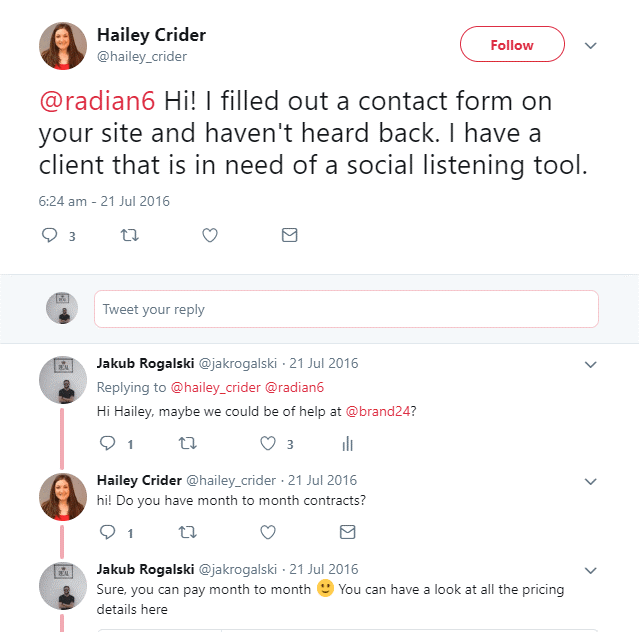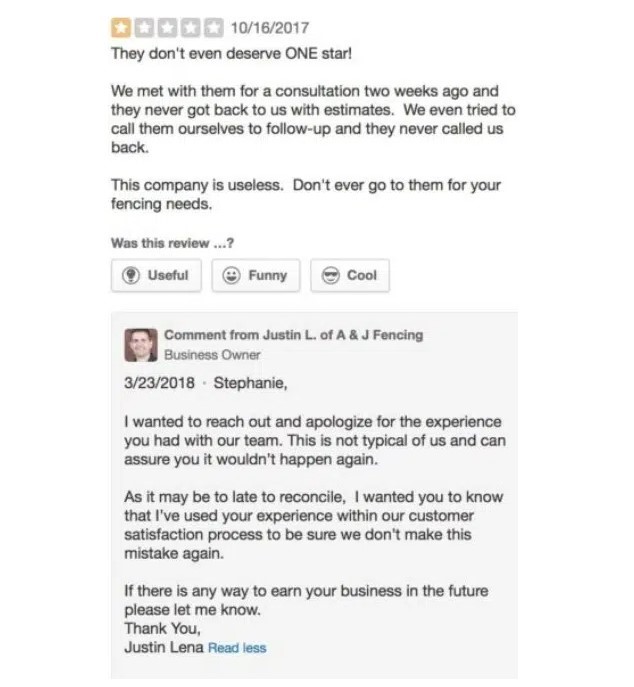Investor Warren Buffet once said, "It takes 20 years to build a reputation and five minutes to ruin it." Reputation matters—and it's fragile. 60% of US consumers wouldn't buy from a brand they perceive as untrustworthy, and 63% of a company's market value is tied to its reputation. Brand reputation management requires skills from being social media savvy to crisis planning.
Brand reputation is understanding how your brand is perceived and taking action to improve its perception. It's only getting more important—84% of millennials don't trust traditional advertising anymore, relying instead on online reviews and information from other consumers.
Big corporations used to be the only ones who had to worry about brand reputation, but in today's world, it matters just as much for small businesses. As a marketer who's worked with a variety of local businesses, I've seen again and again how positive online reviews and raving fans on social media can provide an enormous advantage over the competition.
Customers assess your brand based on factors like trustworthiness, quality of service, and friendliness. By creating a reputation management strategy, you'll know what to do to build more customer loyalty, grow faster, and create a brand that consumers love.
Online Reputation Management
What people are saying online can make your brand go viral in a good way—or in a bad way. With 97% of consumers looking at product reviews before making a purchase, the art of brand reputation management starts online. Brand management software comes in many forms and can be used to put out fires before they start raging.
Social Media
Social media is a powerful amplifier for word of mouth. Decades ago, consumers might tell one or two people about a product they love (or hate). Today, a positive or negative social media post can go viral and reach millions.
Because it's hard to keep track of everything happening across social media, you'll want to use social media management software to organize your efforts. Make sure to choose software with a social listening feature, which notifies you of mentions of your and competitors' brands—even when you're not tagged.
Once you're aware of what people are saying, you'll want to do two things:
- Respond to individual mentions
- Gauge overall social sentiment
In analog times, brands never had an opportunity to be a part of conversations between consumers. Today, you do. Make sure you're jumping in whenever your brand is mentioned, and using analytics for social media reputation management.
You can also uncover opportunities by inserting yourself into conversations about your competitors—as software company Brand24 demonstrates below.

Content Marketing
The Internet is a noisy place. Content marketing is your chance to keep your brand visible to consumers—even with all the other demands on their attention. With a mature content marketing strategy, you can consistently influence consumers' impressions of your company with on-brand messaging.
The key to influencing your reputation with content marketing is to be omnichannel. Blog posts alone won't cut it anymore. Instead, you'll need to be everywhere customers are:
- Blog
- Social
- Video
- Podcasts
Design your content as zero-click content. Don't just post a link to your blog post or podcast on LinkedIn. Instead, take the time to create a "platform native" version of your content that gives viewers value without making them click away from the platform. This approach may result in fewer clicks but significantly greater reach and influence.
By publishing value-driven content across all channels, consumers will start seeing content everywhere that supports a positive brand reputation.
Online Reviews
94% of online shoppers have avoided visiting a business due to a negative review. What customers say about you is more important than what you say about yourself—and that's never been more true than it is today.
But what's counterintuitive is that negative reviews aren't entirely bad. 82% of people who read online reviews actively seek out negative comments to get a complete picture of the product. And in general, more reviews make you more trustworthy, even if a few are negative. Consumers want to see at least 40 reviews to justify your company's "star rating."
While reviews and testimonials naturally accumulate if you have a quality product or service, you can also take steps to encourage reviews proactively. Ask customers to leave a review, then automate a follow-up sequence to remind them.
When it comes to negative reviews, the worst thing you can do is not respond. Responding constructively to negative reviews—as A&J Fencing does in the example from TrustPilot below—shows prospects who read that review in the future that you can use criticism to improve.

Brand Mentions
When people are talking about your brand on social media, they're not necessarily talking to your brand. 96% of conversations about your brand don't involve your official branded accounts. Monitoring tagged and untagged brand mentions allows you to have a complete picture of your brand mentions on social media—not just those you're tagged in.
Whether social conversations are positive or negative, don't let them happen in a vacuum—instead, make yourself part of the conversation. 83% of customers are more loyal to brands that respond to their complaints. That means dealing with complaints not only softens the negative impact on your brand reputation—it also gives you a chance to turn unhappy customers into happy ones.
Speed is another key principle of brand mentions. When customers tag you, respond as fast as possible. Most customers expect a response to a negative complaint on social media within an hour, but 88% of brands don't manage to pull this off.
Brand mentions are also an opportunity to show off your brand's "social media personality." Some of the most viral branded activity on social media happens when brands take friendly shots at each other. This isn't right for every brand, but for some, it's a great fit—as Wendy's shows in the Twitter example below.

SEO
Being at the top of Google search results is important. Pushing down anything negative about your brand is even more important—because just four negative search results can drive away 70% of your potential business.
In 2009, two employees of Domino's Pizza in North Carolina posted YouTube videos showing them flagrantly breaking health codes while preparing food. Domino's quickly had a crisis on its hands. References to this event soon took over five of the most prominent spots in Google when searching "Dominos."
SEO reputation management is focused on maintaining a positive brand image in search engine results. When negative events happen—as in the Domino's example—a positive SEO campaign can often push any unfavorable coverage out of sight.
In the long term, you'll want to grow your website's authority by getting authoritative sites to link to you. This helps boost your rankings over competing content. Ironically, a negative public relations incident might provide just this kind of boost—but positive PR is much preferred.
In the short term, you'll need to deal with negative coverage by drowning it in positive coverage. Google's search results show a variety of results, not necessarily in this order:
- Twitter posts
- YouTube videos
- Google Business posts
- News
- Ads
If you have an immediate need to push negative content down, use every tool at your disposal. Consider issuing a press release. Post on Twitter and Google Business. Create YouTube videos. Pay for ads. The Internet is a noisy place—use this to your advantage.
Offline Reputation Management
Customer Experience
Building a positive customer experience (CX) is your chance to prevent reputation damage before it happens. If your brand provides incredible service, you'll grow naturally due to positive word of mouth. You may even develop a cult following—just look at the devotion inspired by the customer-centric grocery store Trader Joe's.
A poor CX has the opposite effect. As unhappy customer experiences stack up, your online and offline reputation will take hit after hit. Negative chatter will build up on social media, and negative word of mouth will spread.
Your brand reputation management strategy should take CX into account because customer satisfaction is a better way to improve your reputation than damage control. If you think you already have a great customer experience, think again. 80% of companies think their customer experience is "superior"—but only 8% of customers agree.
To improve your CX:
- Start by gathering feedback.
- Survey your customers, hold customer interviews, and gather data with social listening tools.
- Figure out the parts of your experience that customers don't like.
- Start fixing them.
Make sure you use CX metrics like Net Promoter Score (NPS) to judge the results of your efforts. As your NPS starts to rise, you'll see your reputation improve along with it.
Word of Mouth
92% of people trust word-of-mouth referrals—more than any other type of advertising. Before online virality, there was offline virality through word of mouth (remember Beanie Babies?). Unfortunately, word of mouth is also one of the hardest forms of reputation to influence.
To generate positive word of mouth, you need to create an experience that customers can't stop talking about. A single event can get a positive buzz going—like Blaze Pizza's Pi Day, during which you can get a pizza for $3.14. But for sustainable reputation changes, make sure your customer experience is consistently excellent.
It's also possible to "amplify" word of mouth by allocating space in your budget to go above and beyond for customers. In 2010, the grocery store Trader Joe's delivered free groceries to an older man trapped at home during a snowstorm, creating positive buzz about the brand.

Public Relations
You may remember that in 2017, a man was dragged off a United Airlines flight. Videos of the incident spread on social media, and United lost over $1 billion in market value. For months, their brand name was a punchline.
You never want an incident like this to happen, but to give yourself the best chance of preventing long-term damage to your reputation, you need to be prepared for anything.
Common public relations crises include:
- Angry customers: A single angry customer can go viral and spark a PR crisis. Do damage control as quickly as possible. Try to turn each customer's negative experience into a positive one—especially if they post about it on social media.
- Customer service issues: Some of the most hated brands in the world are utility companies with poor customer service. Don't be like them. Train customer support reps to be fast and friendly when resolving support inquiries.
- Employee issues: Rogue employees affect your brand—but you still have to take responsibility for them. Deal with any personnel problems quickly, and communicate how you'll avoid similar ones in the future.
- Outages: Service outages are the most common complaints at otherwise customer-centric companies like Netflix. If this happens, apologize for the inconvenience and communicate what you're doing to prevent future outages.
- Global events: When difficult global news events happen, watch them carefully to see how they intersect with your brand. If it feels like something your brand needs to address, you'll have to do so carefully. Even if you don't get involved, you'll need to check any preplanned email blasts, social media posts, and scheduled product launches to make sure they don't come off as tone-deaf.
To stay on top of potential PR issues, monitor mentions of your company name and product names on social media and in the news. Reputation management tools and social media software can help you monitor social media. Google Alerts can also notify you of mentions of your brand in the news.
Planning Your Reputation Management Strategy
Reputation management isn't just about responding when negative news pops up about your brand. You need a full reputation management strategy—one that encompasses everything from customer experience to crisis management.
Research and Assess
Take stock of your current reputation. Remember, brand perception is all about how the outside world sees you—so it's tricky to determine your reputation yourself. Instead, use a mix of customer feedback and hard data.
Customer feedback
Start by getting an anecdotal sense of your brand's public perception. The quickest way is to go through negative and positive reviews on third-party review sites like Yelp, Google, and Trustpilot. Your priority should be cataloging and addressing frequently mentioned complaints.
Once you've done that, scroll through messages on social media and email. Organize customer comments into "negative" and "positive" buckets. Make a note of the most frequent complaints and questions.
By the end of this process, you should have a list of customer complaints organized by frequency. You should also have a rough sense of your negative-versus-positive ratio of customer feedback.
Data and metrics
Start your data-driven process with social sentiment tools to get an "at-scale" sense of your reputation among the broader public. Next, look at customer metrics like Net Promoter Score to understand your ratio of promoters to detractors. If you still need to survey customers, this is a good opportunity.
Establish Your Strategy
Once you've benchmarked your reputation, it's time to put a strategy in place. You can think about your brand reputation management strategy in two ways: reactive and proactive.
Reactive
Putting out fires comes first. You may find urgent issues to address in the course of your audit. For example, if your assessment found customers were unhappy about poor support, inconsistent product quality, and slow shipping—those are the three things you'll want to focus on first.
You'll also want to create a crisis management plan so your company has a playbook for responding to the next crisis.
Proactive
You don't just want to solve complaints—you also want to give customers a positive reason to become brand advocates. That's where customer experience comes in. Once you've put out the most urgent fires, your next task is to create an experience that makes customers excited to tell their friends and family about you.
A positive customer experience starts with your content strategy—by giving value freely when potential customers first discover your brand—and extends to social media, email, onboarding, and support. Make sure every touchpoint on your customer's journey is a positive experience for them.
Loop in Stakeholders
You may need help managing your brand reputation strategy. Take crisis management, for example—the most high-pressure situation in reputation management. To deal with a crisis, you'll need buy-in from everyone, from your social media manager to your CEO. Depending on the severity of the crisis, your CEO might be expected to make a public statement. Meanwhile, your social media manager needs to know what to say—and what not to say.
Not every brand reputation issue is an intense PR crisis, but as you create your brand reputation strategy, you'll need to loop in stakeholders throughout your company. Consider holding a reputation management kickoff meeting with stakeholders to discuss the issues you're addressing and the changes each team needs to make.
Take Action and Monitor
Once you've implemented your plan, it's time to see what happens. Pick your metrics in advance. Here are some of the most common brand reputation metrics:
- Sentiment Analysis: Social sentiment analysis helps you understand changing feelings toward your brand on social media platforms over time.
- Online Reviews: I'm a fan of measuring customer reviews as a reputation management metric because it gets straight to the heart of why you're paying attention to your brand reputation. Measure your average review score for the six months before your reputation initiatives and the six months after—then compare.
- Net Promoter Score (NPS): NPS measures whether customers are detractors or advocates. As customers become advocates, NPS serves as a leading indicator for your reputation.
- Share of Voice: Widely used in PR, share of voice tracks how much you're being talked about versus competitors. Share of voice measures the number of conversations about your brand divided by the overall volume of conversations in your industry.
Whatever metrics you pick, watch them carefully to make sure your reputation management strategy is having an impact. And continue to monitor customer feedback and complaints—new issues always need to be addressed to keep customers happy.
Building a Brand Customers Love
Everyone wants to build a brand that consumers love—like Apple or Amazon—but most companies don't do the work. And let's be honest, creating a customer-centric brand is in fact a lot of work.
Fortunately, you're already on the right track. Commit to listening to customer critiques, addressing issues fast, and improving your customer experience, and you'll see more and more customers fall in love with your brand.
For more tips on brand building and marketing, don't forget to subscribe to The CMO newsletter so you don't miss out on the latest in marketing strategy, trends, technology, and tools.


